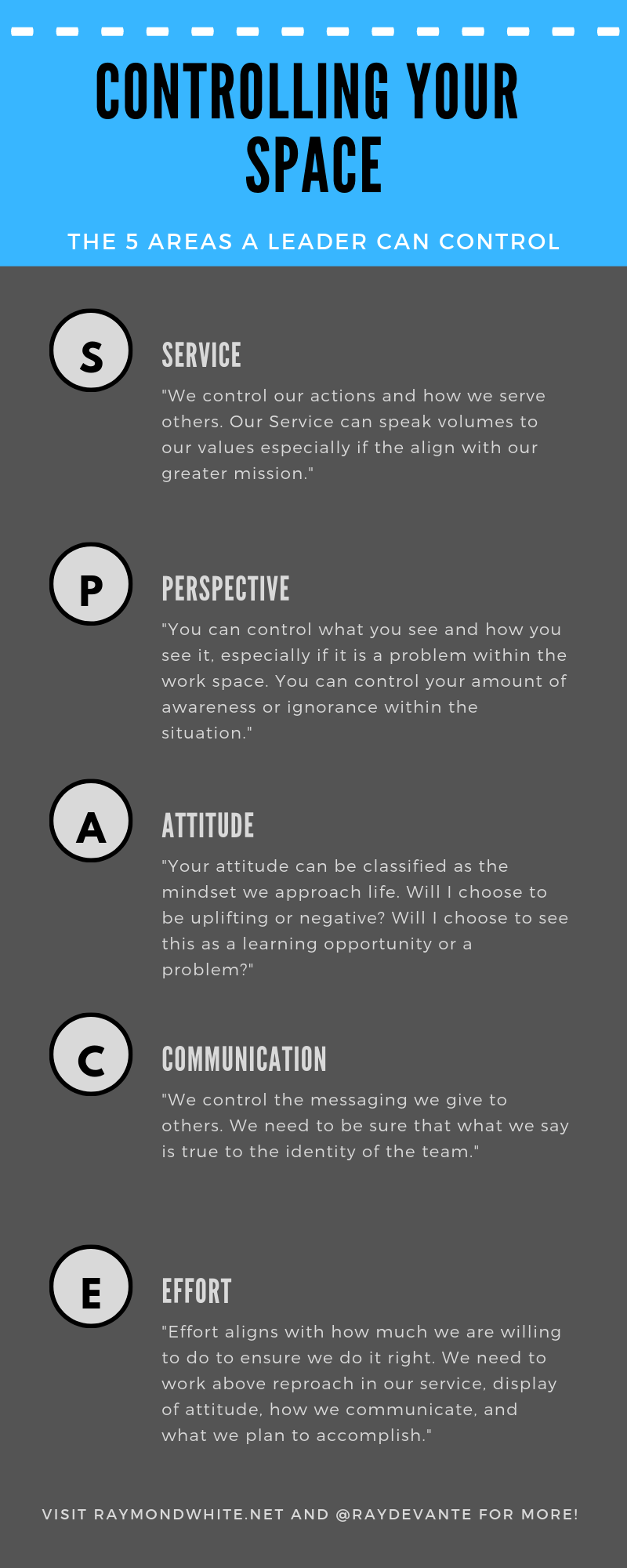Controlling your SPACE
Controlling your SPACE
Five Areas within a Leader’s Control
By Raymond White
In the book Great By Choice, Collins reviews the companies who were profitable during an extended period of time. They compared them to companies that were counterparts in the industry and tried to figure out why one company succeeded more than the other.
In that, one of the chapters, 20 Mile March, highlights that companies who focused on what they could control, were intentional in their actions, and have a consistent mindset of staying the same during any season are the ones that saw the most growth and grit.
I am fascinated by this concept because there can be parallels in how we build resilience for our teams. To endure tough times and stay humble during excelling times.
I am even more fascinated by the idea of what we can and cannot control, as the book highlighted that these companies focused on what was “in scope” of their control and didn’t let external pressures or internal advances dictate how they approached any season.
If we were to look at the success of our teams, we would know that the leader would need to set the pace that fits their goals and strives to build their confidence. They would need to identify what is within their scope of control and make the goal fit the identity of their team. Sure, as a leader, you can model your march to another team/company. But it is important that the march is your own. That you pay attention to how and why you are moving towards a path that is for the long haul.
Let’s talk more about can control. Before, I thought that there only two things that you could control whenever you are faced with a challenge or issue: you effort and attitude. However, I would like to expand on that. I believe there are 3 additional items that we have control over whenever faced with a problem that needs to be addressed.
Truly, we need to think about our SPACE. I'm telling you, I am keen on using acronyms to remember actions:
Controlling your SPACE:
Service
Perspective
Attitude
Communication
Effort
Let’s break it down one by one:
S - Service
We control our actions and how we serve others. I titled it this way not only to fit within my framework, but to also share that our actions should be a service to others. When we face a troubling time, we know that we need to act in a way that is beneficial to others. We can control our hands and feet towards helping someone else get through the day, or to fill a need, and how to do it in a way that is honoring to them. Our Service can speak volumes to our values especially if the align with our greater mission. So, that is the first thing that we can control to stay the course.
P - Perspective
How you see a problem, solution, situation is something that you can control. I don't mean that your way is the right way. But you have the power to go and see things from other's point of view to shape your world view. You can control what you see and how you see it, especially if it is a problem within the work space. If there is a decision you need to make, you can only see it from your perspective, the perspective of one other person, or consult with others who may be impacted by the decision. But you can control your amount of awareness or ignorance.
A - Attitude
One of my "original controllers," your attitude can be classified as the mindset we approach life. Will I choose to be uplifting or negative? Will I choose to see this as a learning opportunity or a problem? My attitude can not be influenced by outside forces, even though I can let it be. Any one of these aspects has the potential to be influenced, but my attitude should be the filter that blocks my perspective and service if I am already choosing how to respond that will keep us moving forward.
C - Communication
I firmly believe we control the messaging we give to others. If someone pisses me off, I can't blame them for making me want to cuss them out. That's on me to communicate in that way. That example might be extreme, but let's view it from a work construct. If there is a financial crisis in the hospital, I have to decide how I want to communicate it that aligns with our path. Or if I am resolving a conflict, I need to be sure that what I say is true to myself and the identity of the team. We have the ability to control the messaging and how we respond.
E - Effort
The other "original controller," Effort aligns with how much we are willing to do to ensure we do it right. The quality, the output, the service. Just cause someone else is doing a crappy job, doesn't give me the go ahead to follow suit. I still need to work above reproach in my service, change of attitude, how I communicate, and what I plan to see.
If you spell this out, it states SPACE. We have the ability to control the spaces we are a part of. Our presence has an impact whether we know it our not. It can change the dynamic of the situation if we let it. We can either make the change or let the change make us. Our approach to the space needs to be shaped by how we control our SPACE.
So now what?
So what are we going to do to control our space? How will we shape the space with our space? Again, we need to be consistent in the way we act for our teams to know where they are going, who we are and who they are. They will know what to expect and how to act if we can articulate these features in our philosophy. Especially if the end goal is do follow the mission, or do the overall good of those around us, we want to be sure that these factors are linked in any way to that outcome.
And, in the end, with our consistent march with the focus of controlling our SPACE, we should growth in our teams culture and the rate in which we exceed our organizational goals.




